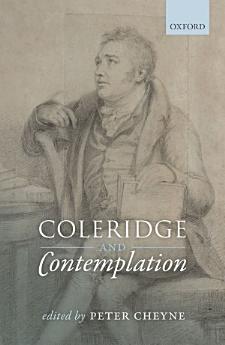Coleridge and Contemplation
Peter Cheyne
ઑગસ્ટ 2017 · Oxford University Press
ઇ-પુસ્તક
352
પેજ
family_home
પાત્ર
info
reportરેટિંગ અને રિવ્યૂ ચકાસેલા નથી વધુ જાણો
આ ઇ-પુસ્તક વિશે
Coleridge and Contemplation is a multi-disciplinary volume on Samuel Taylor Coleridge, founding poet of British Romanticism, critic, and author of philosophical, political, and theological works. In his philosophical writings, Coleridge developed his thinking about the symbolizing imagination, a precursor to contemplation, into a theory of contemplation itself, which for him occurs in its purest form as a manifestation of 'Reason'. Coleridge is a particularly challenging figure because he was a thinker in process, and something of an omnimath, a Renaissance man of the Romantic era. The dynamic quality of his thinking, the 'dark fluxion' pursued but ultimately 'unfixable by thought', and his extensive range of interests make a philosophical yet also multi-disciplinary approach to Coleridge essential. This book is the first collection to feature philosophers and intellectual historians writing on Coleridge's philosophy. This volume opens up a neglected aspect of the work of Britain's greatest philosopher-poet -- his analysis of contemplation, which he considered the highest of human mental powers. Philosophers including Roger Scruton, David E. Cooper, Michael McGhee, Andy Hamilton, and Peter Cheyne contribute original essays on the philosophical, literary, and political implications of Coleridge's views. The volume is edited and introduced by Peter Cheyne, and Baroness Mary Warnock contributes a foreword. The chapters by philosophers are supported by new developments in philosophically minded criticism from leading Coleridge scholars in English departments, including Jim Mays, Kathleen Wheeler, and James Engell. They approach Coleridge as an energetic yet contemplative thinker concerned with the intuition of ideas and the processes of cultivation in self and society. Other chapters, from intellectual historians and theologians, including Douglas Hedley clarify the historical background, and 'religious musings', of Coleridge's thought regarding contemplation.
લેખક વિશે
Peter Cheyne is Associate Professor at Shimane University, where he teaches Philosophy and Literature. He divides his time between Shimane and his native Durham, where he is Visiting Fellow at Durham University Philosophy Department. He has published 'A Coleridgean Account of Meditative Experience' (Journal of Philosophy of Life, Jan. 2013); 'The Art Of Poetic Life-Writing' (Coleridge Bulletin, Winter 2014); 'Encoded and Embodied Rhythm', (eds Hamilton & Paddington, Philosophy of Rhythm, OUP, 2017).
આ ઇ-પુસ્તકને રેટિંગ આપો
તમે શું વિચારો છો અમને જણાવો.
માહિતી વાંચવી
સ્માર્ટફોન અને ટૅબ્લેટ
Android અને iPad/iPhone માટે Google Play Books ઍપ ઇન્સ્ટૉલ કરો. તે તમારા એકાઉન્ટ સાથે ઑટોમૅટિક રીતે સિંક થાય છે અને તમને જ્યાં પણ હો ત્યાં તમને ઑનલાઇન અથવા ઑફલાઇન વાંચવાની મંજૂરી આપે છે.
લૅપટૉપ અને કમ્પ્યુટર
Google Play પર ખરીદેલ ઑડિઓબુકને તમે તમારા કમ્પ્યુટરના વેબ બ્રાઉઝરનો ઉપયોગ કરીને સાંભળી શકો છો.
eReaders અને અન્ય ડિવાઇસ
Kobo ઇ-રીડર જેવા ઇ-ઇંક ડિવાઇસ પર વાંચવા માટે, તમારે ફાઇલને ડાઉનલોડ કરીને તમારા ડિવાઇસ પર ટ્રાન્સફર કરવાની જરૂર પડશે. સપોર્ટેડ ઇ-રીડર પર ફાઇલો ટ્રાન્સ્ફર કરવા માટે સહાયતા કેન્દ્રની વિગતવાર સૂચનાઓ અનુસરો.







